Kohlrabi – have you ever heard of the vegetable with this unusual name?
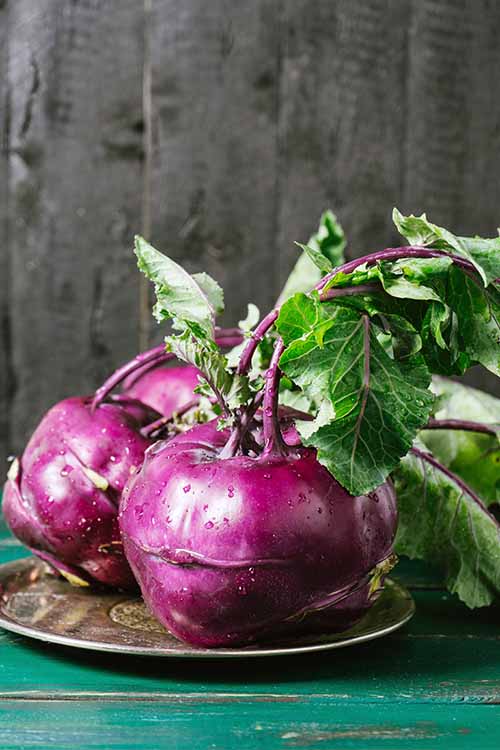
The round turnip-like bulbs offer a variety of uses in the kitchen. With their firm flesh and subtle taste they make not only a great side dish, but also much more.
Let’s find out more about this white and green (and sometimes purple) veggie, its characteristics, and what you can do to jazz up your menu with it!
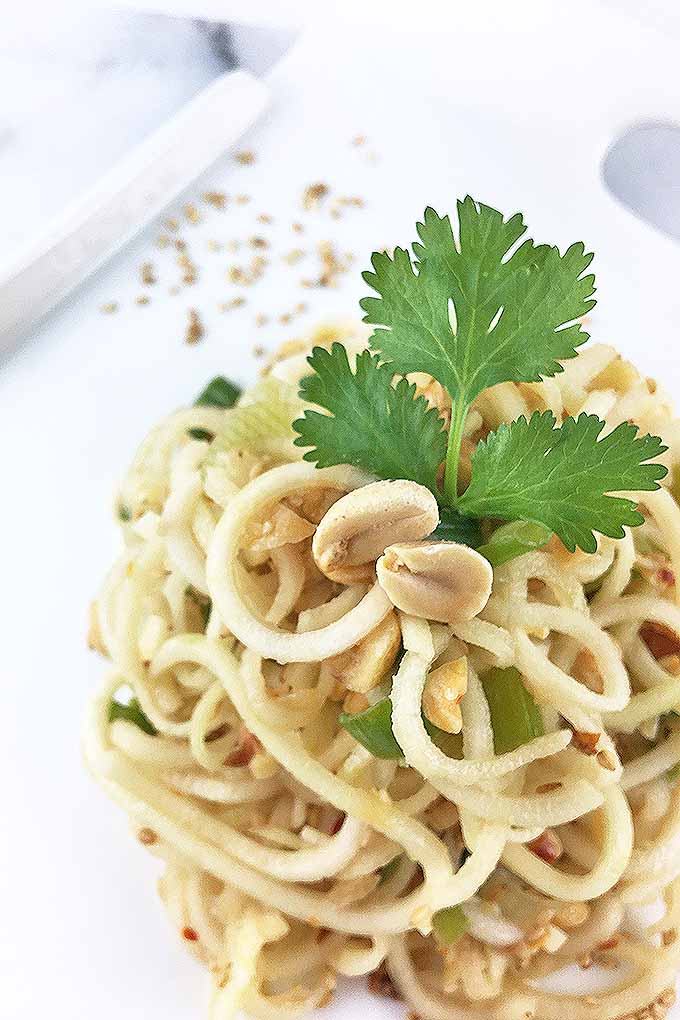
Origin & Classification
First of all, what’s the deal with the interesting name?
Because no other countries consume as much of this vegetable as the Germans do, its local name has been adopted internationally. English, Japanese, and Russian speaking people also know it by this distinct name.
In the original German, “kohl” means cabbage, and “rabi” (a Swiss German variant of rübe) means turnip. Put them together, and what do you get? Kohlrabi, or “turnip cabbage.”
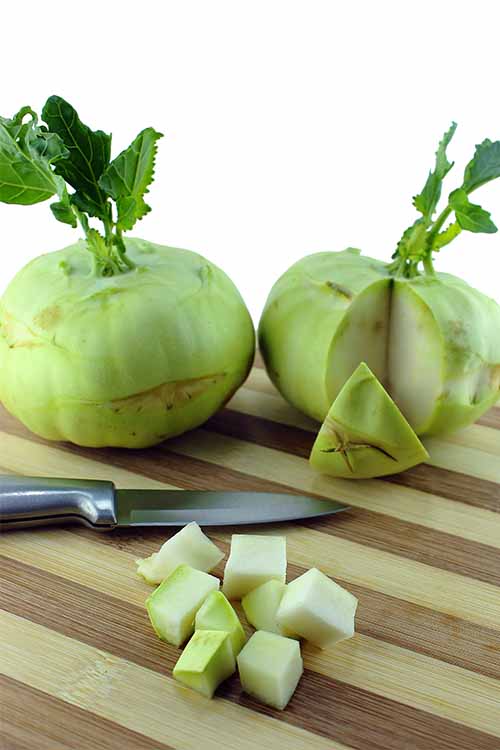
Besides Germany, where the vegetable first gained popularity, Austria, Switzerland, Italy, Spain, Vietnam, and the United States are all producers of this special brassica. According to Matt Duckor at Epicurious, the vegetable first appeared in Italy, where drawings of it in herbal books have been found as far back as the 16th century.
The bulb (more like an enlarged tuberous stem, really) grows aboveground and can reach a size of up to 8 inches (20 centimeters) in diameter, however, its texture is best if harvested when it is between 2 and 4 inches around. The bulb becomes tough and woody in texture as it grows.
Its shape is a round, squat bulb, similar to a turnip. Leaves grow on top, and stems extend from the middle of the bulb like long, thin arms.
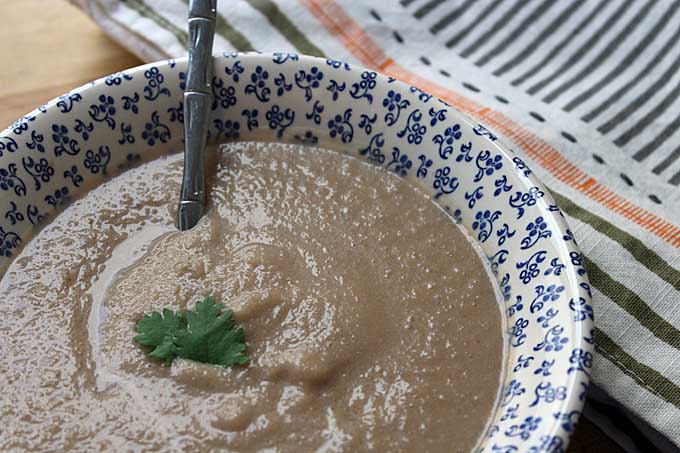
According to the University of California Berkeley Wellness blog, the vegetable contains lots of vitamins and minerals, include high amounts of vitamins C, B6, and E as well as potassium. It’s also a good source of glucosinolates (like other members of the cabbage family) which may improve antioxidant functions of the body.
Its flavor makes kohlrabi a perfect vegetable to combine with several types of spices and other vegetables, and it can be prepared in a variety of ways.
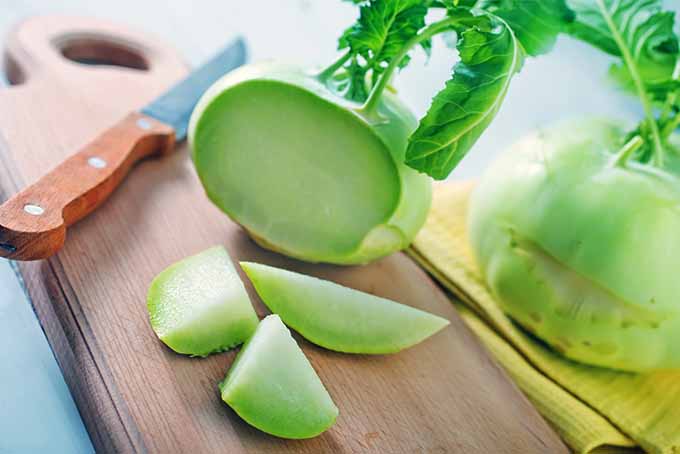
Choosing the Best
The best way to detect the freshness of the veggie in the grocery store or at the farmers market is to have a close look at its surface.
It should feel firm, and have smooth skin without any spots or cracks. If the leaves are still on, they should look fresh and crunchy.
It can be difficult to avoid choosing specimens with that unwanted woody flavor based on appearance alone. But in general, smaller kohlrabi tend to taste less woody than bigger ones.
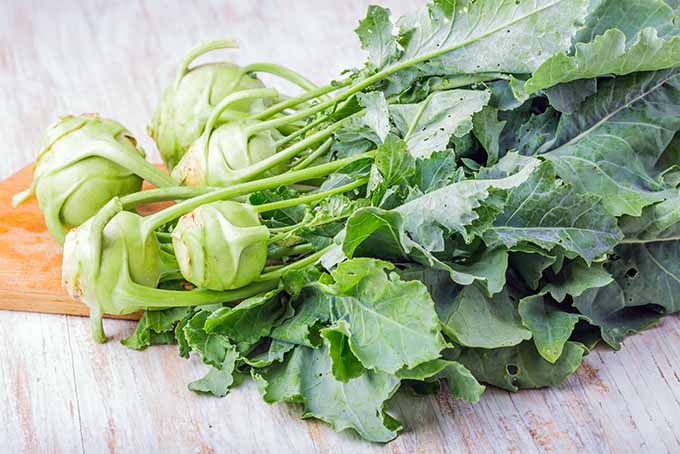
How to Store Properly
There are some details you should know in order to keep kohlrabi fresh at home.
The best way to store this vegetable is to remove any leaves (and reserve them for later – they are quite tasty as well) and keep the bulb in the fridge, wrapped in a moist kitchen towel or in a plastic bag in the vegetable drawer. This will keep your kohlrabi crunchy for about a week.
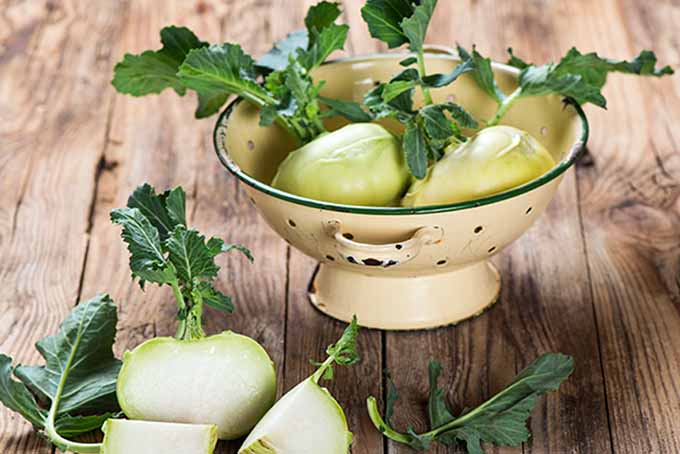
Once you cut it, if you do not wish to consume the whole vegetable at once, you can wrap the cut surface with plastic wrap so it doesn’t dry out. If you cut the vegetable into smaller pieces, they can be stored in an airtight container or plastic bag. Consume cut kohlrabi within a few days.
Freezing is also an option, if you’d like to be able to store kohlrabi for longer periods.
Peel and cut the flesh into chunks or slices, and blanch the pieces for about three minutes in boiling water. Transfer from the boiling water to an ice water bath to stop the cooking, then strain, blot dry, and store in an airtight container before putting it into the freezer. This is especially helpful to prevent a change in texture and color when thawing and cooking again.
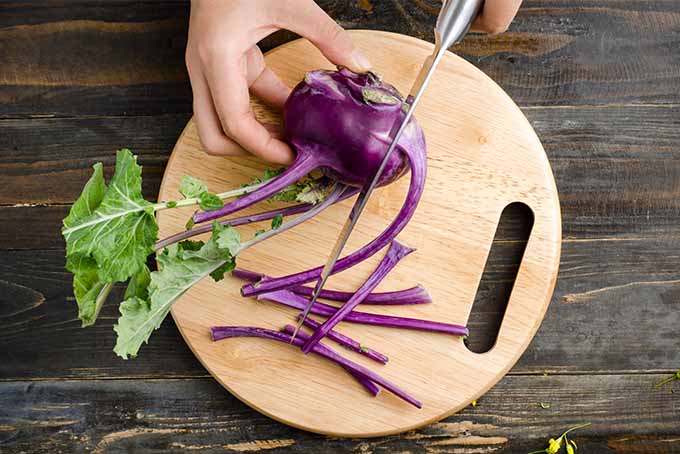
When it comes to the leaves, they have a much shorter shelf life. These will only stay fresh for a few days.
Wait to wash the leaves until right before you are ready to consume them, or they will rot quickly. Store in the refrigerator in a plastic bag, wrapped in paper towels if they are damp when you bring them home.
Preparation Tips
If possible, it’s a great idea to use the leaves because they contain lots of nutrients, even more than the bulbs.
The flavor of the leaves has been compared to kale or collard greens. Why not roughly chop and add them to a salad, or blanch or sauté them for a few minutes to serve as a side?
However you are going to process the bulb, always make sure to remove the stalks and any rough edges around the base first. They will taste woody with a hard texture, and therefore aren’t suited for consumption.
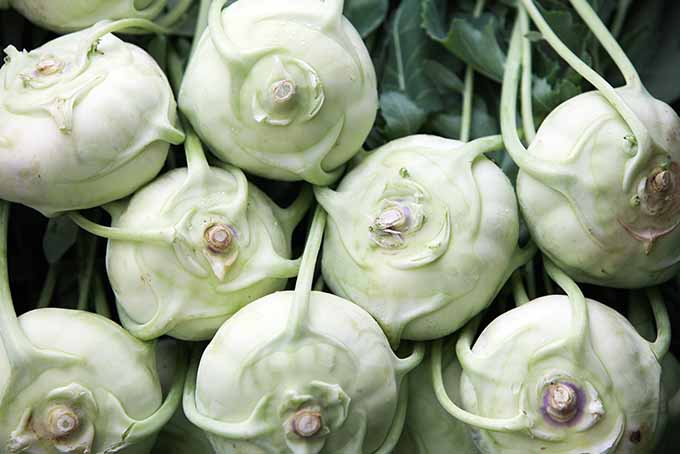
After that, peel the skin with a small knife or a vegetable peeler and cut into chunks, slices, or strips – whatever you prefer or that your recipe requires.
Another great advantage of this vegetable is that is can be consumed raw. Shredded or finely chopped, kohlrabi makes a great addition to raw salads and also works as a healthy snack. Its raw flavor is similar to a sweet turnip with a texture like an apple.
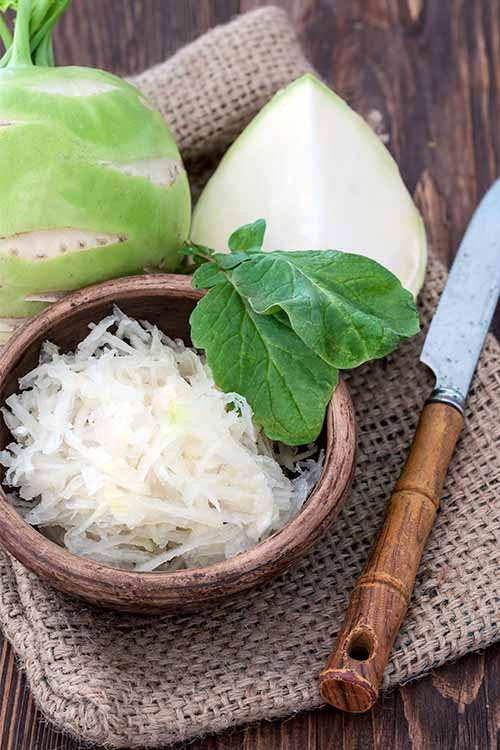
In general, the cooking time for a whole bulb is 20 to 30 minutes, depending on the size. Chopped, the cook time decreases to 15 to 20 minutes. Steam the vegetable rather than boiling, to preserve the nutrients.
The test cooks over at The Kitchn also recommend roasting it, as it caramelizes in the high heat.
It’s delicious in combination with other root vegetables, especially in a root veggie roast, as recommended above; and it’s also great when blended to make our recipe for creamy vegan kohlrabi soup.
Kohlrabi also makes an excellent pickle, or it can be shredded and made into fritters or a raw slaw with a vinagrette or mayonnaise dressing.
Flavor Combinations
If you’re a fan of creative cooking, there is no better friend to have than kohlrabi. This member of the brassica family goes well with numerous spices and herbs. In fact, I haven’t come across a flavor combination that I didn’t enjoy. It is the perfect base to test a wide variety of flavor combinations.
Some of my favorite flavor combinations include caraway, curry, nutmeg, tarragon, and thyme.
According to Karen Page and Andrew Dornenburg’s bestselling book The Flavor Bible, available on Amazon, some additional herbs and spices that pair well with this veggie are:
- allspice
- basil
- cheese (Parmesan or Swiss)
- chervil
- cilantro/coriander
- dill
- mustard
- parsley
- rosemary
- turmeric
It also pairs nicely with the pungent herb ramson, similar to North American ramps.
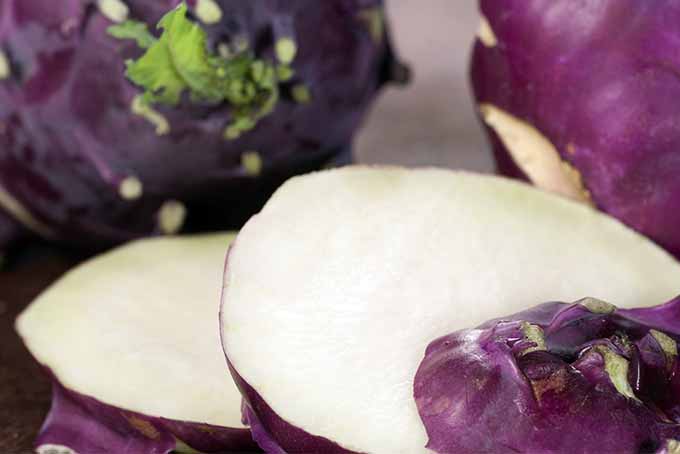
Try it with other vegetables too, like cabbage, carrots, celery, leeks, onions, and potatoes.
Cooking Ideas
Provided that you can find a few medium-sized kohlrabi, I have three wonderful ideas for you to try out at home:
1. Fill It
Did you enjoy my recipe for stuffed onions? This recipe is just as delicious when it’s made with kohlrabi instead.
Boil the bulbs whole in vegetable or chicken stock (with stems, leaves, and any tough ends removed), then let them cool. Remove the tops, and hollow them out.
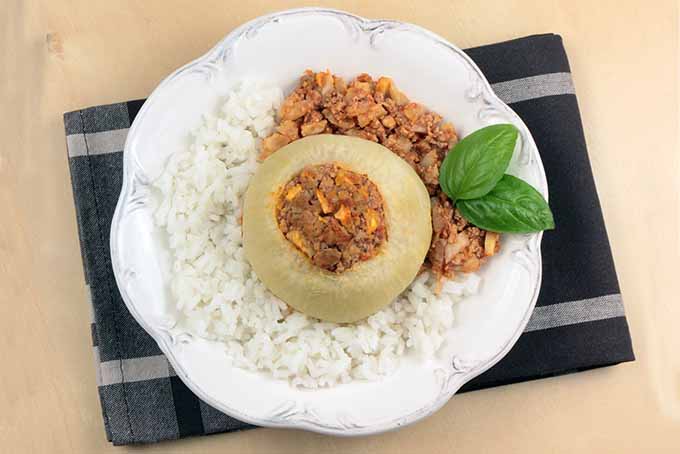
Just as you did with the onions, this hollowed out portion can be added to the stuffing. The remaining directions and suggestions for the recipe stay the same.
2. Spiralize It
For a refreshing raw salad with a spicy sauce packed with flavorful ingredients like rice vinegar, ginger, soy sauce, and lots of pepper flakes, give my recipe for spicy spiralized kohlrabi slaw a try.
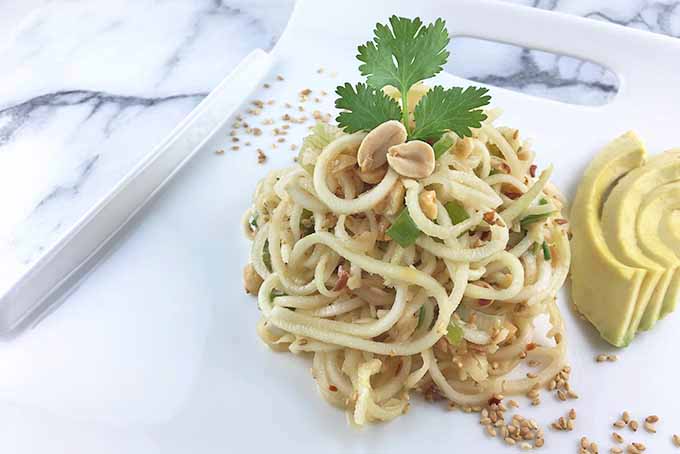
3. Fry It
Make some vegetarian cutlets! For this dish, cook the bulb whole until it is al dente – you don’t want it to become too soft.
Leave to cool, and then slice lengthwise into 1-inch-thick pieces. Toss in beaten eggs and breadcrumbs, and fry in a pan with butter or olive oil until golden brown on both sides.
Tip: For a more crunchy texture, do not cook the kohlrabi before breading and frying it. The centers will remain crisp, with a fresh, sweet flavor.
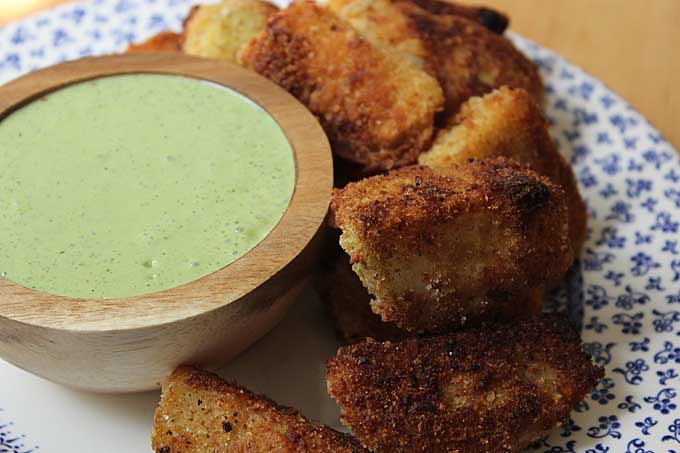
Time to Raid the Produce Section
Kohlrabi is a versatile member of the cabbage family. It has a subtle and mild flavor, is easy to prepare, and pairs nicely with many different spices that you probably already have in your rack at home.
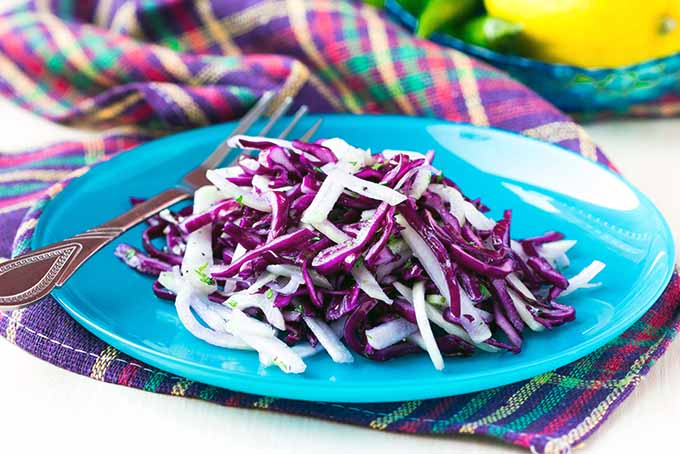
Plus, you can enjoy it raw in salads or as a great veggie snack dipped in hummus.
Why are so many people still unfamiliar with it? Beats me! But you can change that – head down to your local farmers market or grocer and buy a few bulbs when they’re in season.
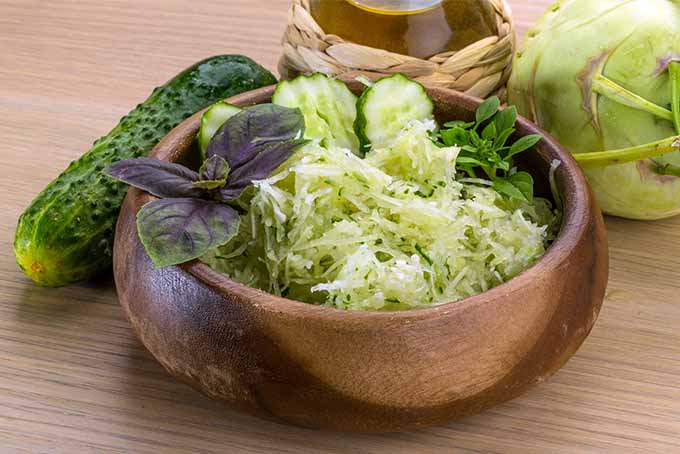
What is your experience with this vegetable? Have you ever cooked with kohlrabi?
If so, how did you prepare it, and what additional recipes can you recommend? Share your thoughts and ideas in the comments below!
Photo credits: Shutterstock, unless otherwise noted. Additional writing and editing contributed by Kendall Vanderslice and Allison Sidhu.
About Nina-Kristin Isensee
Nina lives in Iserlohn, Germany and holds an MA in Art History (Medieval and Renaissance Studies). She is currently working as a freelance writer in various fields. She enjoys travel, photography, cooking, and baking. Nina tries to cook from scratch every day when she has the time and enjoys trying out new spices and ingredients, as well as surprising her family with new cake creations.






Well, to my knowledge, I’ve never eaten kohlrabi, However, I love cabbage and I was excited to find this and taste some! Alas, I went to the farmer’s market and to the grocery store in town that has the largest selection of produce. Both did not carry kohlrabi. So, I am going to have to figure out where I can get it locally.
What a pity that you couldn’t find some on the farmer’s market as well. I really hope for you to find some other place, because if you’re a cabbage-fan, this one is definitely worth to try. I’m sure you would like it and the different ways you can combine and prepare it.
I grow my own in the garden. You can start with seed or my local nursery has seedlings which gives you a head start. I did the latter this year and have just harvested them (July 11). This is much earlier than planting from seed. I like to eat them raw as my healthy snack.????
No, I’ve never cooked with it and I don’t believe, I’ve ever eaten it. It’s time to start preparing for the fall garden and my dad gave me some seeds not to long ago, this article has given me the push to plant a few.
Oh that’s great! I haven’t planted some on my own, because I haven’t got the space, but I’ll keep my fingers crossed that those seeds will provide you with some wonderful and fleshy kohlrabi once they’re ready. 🙂 Good luck!
If you have limited space, we have grown kohlrabis in pots. They don’t get as big as they do in the ground but it is so nice to have them available fresh.
Can’t say I’ve ever eaten that either, but I’m looking forward to one day if I ever find it. I’ve never seen this type of vegetable at our farmers market which leads me to believe that they don’t stock it. How unfortunate, it would have been very nice to experiment with a new flavor.
You’re right, I also enjoy trying out new products. I hope that some farmers might have just hidden them 😉 , and you’ll be able to buy them some time, good luck!
What an unusual vegetable. I have never seen this in England! I think I’d like to try it, though, as your description of the flavour sounds very interesting. Thanks for sharing this.
I would have thought it would be available in England, too. But maybe you’re still lucky to find some around. It is really a great veggie to try, because it’s so versatile. When you’ve got the chance to get some, you should go ahead 🙂
I went from not knowing what this vegetable was, to knowing quite a bit about it after reading your post. Great job!
We had a roasted kohlrabi for dinner tonight! It was delicious – a great substitute for potatoes. I peeled and cut it into chunks, tossed it with olive oil, salt, pepper, and some herbs, placed it in a glass baking dish and roasted for 40 minutes on 400 degrees. At the last 10 minutes I tossed in some leftover brats cut up. I ate it with sour cream and my husband used ketchup. I think parmesan cheese would have been good too. It was really delicious and filling. Thanks for your additional ideas!
cubed covered in olive oil with seasoning salt (your favorite) on kabobs grilled till tender.
When I married 34 years ago, I was surprised to find that my new wife’s family had always enjoyed them as mine did! They are easy to grow, start them early and transplant, they can also be grown late summer. They are delicious sliced raw, with a little salt. I grew one once that weighed 45#!
Holy COW!
My husband is growing kohlrabi as I am reading your info, and I needed to know how to store and cook this interesting veggie. I shall certainly try your recipes. Do you know of slow cooker or dutch oven recipes? Thank you.
Yum, enjoy the homegrown kohlrabi, Carol! It makes a delicious substitute in any slow cooked recipes that call for root vegetables, such as our beef and vegetable stew.
I just went to a farmers market with my daughter and she asked me to buy some. I didn’t know anything about them. The seller said just eat it as an apple or cook them. So far we have cut one up and ate it like an apple. We liked them. So I looked up to how to cook them. We will try roasting them because we roast a lot of other vegetables. Enjoyed your page. Thanks
I grew up eating kohlrabi raw like carrot sticks. It is sweet and crunchy. I am excited to try roasting it. I’m guessing that will bring out the flavor even more.
I have bought fresh kohlrabi 2 days ago and tried 2 recipes.
Pasta farfalle with kohlrabi spring onions
chicken soy sauce yogurt and spices
Kohlrabi potatoes soup
Both delicious
We had kohlrabi for the first time at a friend’s a couple years ago and look forward to it every summer. This summer we container gardened and should have some soon. We love it sliced raw with a little salt on it but will be putting it in salads too.
Kohlrabi is super easy to grow here in Wisconsin, I’ve grown my own every year! I just eat eat it raw, fresh out of the garden, peeled with salt sprinkled on it, Love it! My mother however peels it and cooks it like mashed potatoes. She likes it that way, I will always eat mine raw! I never heard of anyone eating the leaves before but after reading this I am going to try it. Thanks
Being German it has been eaten in our family for generations. We love it raw with salt, made into soup as well.
You can make a creamy vegetable soup with dumplings. Or we also make it with other vegetables, dumplings and a smoked pork hock for the meat.
So easy to grow.
How do I store fresh Kohlrabi “Linguine”?
The instructions on the bag I bought stated: Microwave in bag for 4-5 Minutes. There are only me and my husband, so – How do I store the left-over Kohlrabi “Linguine”?
Spiralized vegetables don’t have a very long shelf life, and I would assume these are just cut kohlrabi strips without any added preservatives. You should be able to store any uncooked veggie “noodles” the same way you would other cut vegetables, in an airtight bag or container in the refrigerator, either on the shelf or in the crisper drawer. If the leftovers are already cooked, you should be able to store them for a day or two in an airtight container in the refrigerator and reheat them in the microwave. Discard leftovers if you notice any discoloration or off odors, and do not keep them past the expiration date on the package if fresh.
I froze the leftovers but now I’m not sure how to reheat.
Did you store frozen leftover spiralized kohlrabi that has already been cooked, or some other form of the vegetable?
Frozen spiralized vegetables that have not been cooked can be steamed or lightly sauteed in a skillet directly from the freezer. Cooked, they can be treated the same way, or microwaved until heated through. But note that the moisture they contain may result in soggier results than if you had cooked them from fresh.
KOHLRABI, where have YOU been all my LIFE????
Grew kohlrabi for the first time in my 52 years and I’m in LOVE! I made fritters of shredded kohlrabi, pressed garlic, salt, and cassava flour….cooked in a little olive oil, sprinkled fresh dill on top and now I want this for every meal !!!
We’re so glad you discovered it, April! Enjoy!
Made Kohlrabi Fries. Tossed Kohlrabi with a little oil, seasoned with salt, pepper, paprika and cooked in the Air Fryer. Delicious.
We fry slices of kohlrabi in butter with a touch of mustard. Serve it as a side for pork dishes. Love the post it has opened up a whole new way for me to use them. They are seasonal here so that might explain why some people can not find them in the stores.
Glad we could give you some new ideas, Deb! Thanks for reading!
Our experiment growing kohlrabi was so successful that now I’m looking up how to store the crop before they go up to seed!
Like others, we enjoy picking kohlrabi fresh to add to soup (a great turnip alternative), roast with other vegetables and chop for dipping sticks for hummus or guacamole.
Definitely a winner in our garden that we’ll grow again.
Excellent, thanks for sharing Judy! You may enjoy perusing the kohlrabi growing guides on our sister site, Gardener’s Path.
I grow kohlrabi every year. We really prefer it cut into chunks or strips. We dip it into ranch dressing and it is soooo delicious. We also love it in salads.
I make kohlrabi coal slaw in summer through fall at home and every family gathering. Nothing goes to waste.
Home gown kohlrabi and carrots shredded, diced honey crisp apples, thinly sliced and diced vidalia onions (or any other sweet onion that’s in season in Michigan), sesame oil, salt and pepper to taste, and poppy seed dressing (don’t overcoat it). My husband and family loves it.
Thanks for letting me know how to store and use this wonderful vegatable.
Pamela, what sweet words! We love your philosophy on not wasting precious and fresh ingredients.